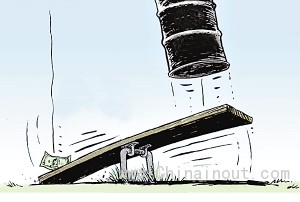自6月中旬以來(lái),,每桶原油的價(jià)格下跌了25美元,跌幅超過(guò)20%,,這引發(fā)了許多問(wèn)題,。油價(jià)會(huì)跌到什么程度?如果油價(jià)出現(xiàn)反彈,,它們會(huì)穩(wěn)定在什么水平,?沙特阿拉伯和歐佩克(OPEC)會(huì)在下個(gè)月會(huì)晤時(shí)削減產(chǎn)能么,?油價(jià)在什么水平時(shí),美國(guó)頁(yè)巖油產(chǎn)量會(huì)受到影響,,會(huì)受到多大影響,?
有一點(diǎn)是肯定的:即使是當(dāng)前的較低油價(jià),也在迅速催生贏家和輸家,。油價(jià)大跌的輸家是石油生產(chǎn)國(guó),、各個(gè)國(guó)家和他們的政府。如果布倫特基準(zhǔn)原油(Brent)價(jià)格指數(shù)跌至每桶80美元,,歐佩克國(guó)家近期的一萬(wàn)億美元盈利就會(huì)被抹去大約2000億美元,。這不僅會(huì)影響到他們的盈利能力,讓他們無(wú)法實(shí)現(xiàn)阿拉伯之春(Arab Spring)后增加的預(yù)算,,還會(huì)影響他們的償債能力,,讓他們無(wú)法在不違約的情況下償還所負(fù)債務(wù)的利息。此外,,如果油價(jià)下跌過(guò)多,,美國(guó)將被迫削減用于擴(kuò)大產(chǎn)能的資本開(kāi)支,這可能會(huì)延緩美國(guó)頁(yè)巖氣革命的進(jìn)程,。
另一方面,,油價(jià)大跌等價(jià)于一次超大規(guī)模量化寬松計(jì)劃,它將有助于刺激磕磕絆絆的經(jīng)濟(jì)增長(zhǎng),,全球經(jīng)濟(jì)總體會(huì)因此受益,。每天,油價(jià)下跌會(huì)帶來(lái)18億美元的額外之財(cái),,這每年會(huì)產(chǎn)生大約6600億美元的資金,。讓我們跟蹤調(diào)查一下原油價(jià)格下跌對(duì)汽油價(jià)格的影響,在美國(guó),,去年每戶人家用于汽油的費(fèi)用約為2900美元,,油價(jià)下跌帶來(lái)的收益等價(jià)于每戶不到600美元的稅收折扣。這將對(duì)全球所有消費(fèi)者產(chǎn)生影響——除了那些燃油開(kāi)支本已極低的歐佩克國(guó)家消費(fèi)者以外,。
油價(jià)下跌有幾個(gè)原因:部分原因要?dú)w結(jié)為市場(chǎng)情緒的影響,,部分則是出于市場(chǎng)基本面的原因,還有很大一部分原因要?dú)w結(jié)為地緣政治格局的影響,。自利比亞戰(zhàn)亂令市場(chǎng)削減了100萬(wàn)桶原油產(chǎn)能之后,,布倫特基準(zhǔn)原油的價(jià)格平均為每桶110美元左右。盡管2011年沙特提升了原油產(chǎn)量,,每桶110美元的布倫特原油價(jià)格還是比利比亞開(kāi)戰(zhàn)前高了大約25美元,。沙特?zé)o法壓低油價(jià)的主要原因是,受戰(zhàn)亂影響的原油是輕質(zhì)低硫原油,,需要這類原油的煉油廠無(wú)法用密度較高,、含硫量較大的原油取代它,。
與此同時(shí),自2011年開(kāi)始出現(xiàn)了兩個(gè)截然不同的傾向,。第一個(gè)傾向是石油出口國(guó)國(guó)內(nèi)紛紛出現(xiàn)治理問(wèn)題,。2011年2月份以前,每天只有大約40萬(wàn)桶原油的產(chǎn)能受到戰(zhàn)亂影響,。在那之后,,算上受制裁的伊朗的石油產(chǎn)能,以及產(chǎn)自尼日利亞,、蘇丹,、敘利亞及也門等受制裁國(guó)家的原油,受戰(zhàn)亂影響的產(chǎn)能時(shí)常攀升至每天350萬(wàn)桶的規(guī)模,,這導(dǎo)致了地緣政治上的緊張局面,。
第二個(gè)傾向則是美國(guó)石油產(chǎn)量的巨大增長(zhǎng)。石油生產(chǎn)的成本每年都在下降,,盈虧平衡成本正大幅跌落至難以置信的水平,,遠(yuǎn)低于每桶75美元。
對(duì)于歐佩克國(guó)家來(lái)說(shuō),,其中一個(gè)困境源自兩類國(guó)家之間的利益劃分問(wèn)題,。一類是生產(chǎn)含硫輕油、中質(zhì)原油和重質(zhì)原油的海灣國(guó)家,,另一類則是生產(chǎn)輕質(zhì)原油的西方及北非國(guó)家,。美國(guó)大幅增加的供應(yīng)量是輕質(zhì)低硫原油,這已導(dǎo)致全球這類原油供過(guò)于求,。無(wú)論沙特和其他歐佩克國(guó)家削減多少原油產(chǎn)能,,都無(wú)法消除輕質(zhì)原油在市場(chǎng)中的供應(yīng)過(guò)剩。
不過(guò),,還有其他基本面因素在發(fā)揮作用。全球經(jīng)濟(jì)十分疲弱,,石油需求的增長(zhǎng)率每天還不到1百萬(wàn)桶,。然而,任何一個(gè)對(duì)2015年經(jīng)濟(jì)活動(dòng)和原油需求增長(zhǎng)的預(yù)測(cè)給出的總體供應(yīng)過(guò)??赡芏紩?huì)在每天1百萬(wàn)桶以上,。如果歐佩克不削減產(chǎn)能,這會(huì)對(duì)油價(jià)產(chǎn)生更大的下行壓力,。此外,,至少在短期內(nèi),政治風(fēng)險(xiǎn)似乎仍是油價(jià)的利空因素而非利多因素,。伊朗核能協(xié)議可能會(huì)導(dǎo)致更多石油投向市場(chǎng),,而利比亞產(chǎn)能繼續(xù)激增也會(huì)產(chǎn)生同樣效果,。
最后,價(jià)格疲軟引發(fā)了一系列陰謀論,。這些言論認(rèn)為,,沙特阿拉伯為了亞洲客戶的利益壓低了石油價(jià)格,而伊朗,、伊拉克及其他中東石油生產(chǎn)國(guó)如今也在競(jìng)相壓價(jià),。沙特領(lǐng)導(dǎo)人發(fā)表的聲明指出,他們認(rèn)為,,大大低于90美元的石油價(jià)格會(huì)限制美國(guó)產(chǎn)量的增長(zhǎng),。他們還認(rèn)為,顯而易見(jiàn)的是,,當(dāng)布倫特基準(zhǔn)原油的價(jià)格為每桶90美元時(shí),,布倫特與美國(guó)基準(zhǔn)原油西德克薩斯中質(zhì)原油(WTI)之間的巨大差價(jià)會(huì)在2015年將WTI價(jià)格指數(shù)壓低至每桶75美元以下。此外,,較低的價(jià)格會(huì)為伊朗和俄羅斯帶來(lái)巨大代價(jià),。這兩個(gè)國(guó)家都在以沙特并不喜歡的方式向中東投入資金。
這些傳聞是真的么,?只有時(shí)間(或許還有11月份召開(kāi)的歐佩克會(huì)議)能告訴我們這個(gè)問(wèn)題的答案,。如果油價(jià)繼續(xù)下跌,事實(shí)可能會(huì)證明美國(guó)生產(chǎn)商的承受能力大大強(qiáng)于人們的預(yù)期,。(中國(guó)進(jìn)出口網(wǎng))

Crude oil prices have plunged by $25, or more than 20 per cent, since mid-June, raising many questions. How low might prices go? If they rebound, at what level will they stabilise? Will Saudi Arabia and Opec move to cut output when they meet next month? At what price level might US shale oil production be affected and how severely?
One thing is certain: even the current lower prices are rapidly creating winners and losers. Losers are producers, countries and governments. If Brent falls to $80, Opec countries would lose some $200bn of their recent $1tn in earnings, affecting not only their ability to earn enough to cover the post-Arab Spring expanded budgets, but also their capacity to service debt without triggering defaults. And for the US, if prices fall much further, capital expenditures to expand production would have to be cut, potentially slowing the US shale revolution.
On the other hand, the world economy as a whole would enjoy the equivalent of a huge quantitative easing programme, helping to spur sputtering economic growth. The decline in prices would generate a $1.8bn daily windfall, some $660bn annualised. Tracking this into gasoline prices, in the US, wher last year some $2,900 per household was spent on gasoline, the windfall would amount to a tax rebate of just under $600 per household. It would affect all consumers globally save for those in Opec countries, who already pay little for fuel.
Prices have plummeted for several reasons: some of the decline is attributable to market sentiment, some to market fundamentals and, to a large measure, the geopolitical landscape. Brent crude has averaged around $110 per barrel since the Libyan disruption took 1m barrels per day off markets. Despite a Saudi production increase in 2011, $110 Brent was about $25 a barrel above traded prices just before the Libyan disruption. The main reason why Saudi Arabia could not damp prices was that the disrupted supply was light sweet crude, and refiners who needed it could not replac it with heavier, higher sulphur-content crude.
Meanwhile, two different trends have unfolded since 2011. The first has been the rise of domestic governance problems across oil exporters. Before February 2011, only some 400,000 b/d of oil was off-market because of disruption. Since then, disrupted supply has grown to more than 3.5m b/d at times, counting sanctioned Iranian oil and crude from Nigeria, Sudan, Syria and Yemen, to name a few, leading to geopolitical jitters.
The second trend is the tremendous growth of US oil output. Production is getting less costly every year and break-even costs are plummeting to much lower levels than commonly believed, certainly lower than $75 per barrel.
One of the dilemmas for Opec stems from the division of interests of the sour, medium and heavy oil producers of the Gulf and the light crude producers in west and north Africa. The US supply surge is light and sweet and has created a glut of this kind of oil globally. No matter how much crude oil Saudi or the rest of Opec cuts, it will not correct the oversupply of light crude in the market.
Yet other fundamentals are also at work. The global economy is weak and oil demand is rising at the puny rate of less than 1m b/d. Any projected increase in economic activity and demand for 2015 will probably leave an overall surplus of 1m b/d, which would weigh even more heavily on prices unless Opec cuts production. Political risk also appears more bearish than bullish, at least for the near term. An Iranian nuclear deal would mean more oil on the market, as would a continued surge in Libyan production.
Finally, price weakness has resulted in a host of conspiracy theories, based on Saudi Arabia having lowered the price of its oil for customers in Asia – price cuts now matched by Iran, Iraq and other Middle East producers. Statements by Saudi leaders indicate that they think US production growth would be hampered with oil prices much below $90, and it is already clear that with Brent at $90, a widening spread between Brent and WTI, the US benchmark, in 2015 could bring WTI below $75 a barrel. Additionally, lower prices would cost Iran and Russia dearly. Both countries are spending money in the Middle East in ways the kingdom does not like.
Are these rumours valid? only time, and perhaps the Opec meeting in November, will tell. If prices continue to fall, US producers could prove to be a more resilient bunch than is commonly thought.
有一點(diǎn)是肯定的:即使是當(dāng)前的較低油價(jià),也在迅速催生贏家和輸家,。油價(jià)大跌的輸家是石油生產(chǎn)國(guó),、各個(gè)國(guó)家和他們的政府。如果布倫特基準(zhǔn)原油(Brent)價(jià)格指數(shù)跌至每桶80美元,,歐佩克國(guó)家近期的一萬(wàn)億美元盈利就會(huì)被抹去大約2000億美元,。這不僅會(huì)影響到他們的盈利能力,讓他們無(wú)法實(shí)現(xiàn)阿拉伯之春(Arab Spring)后增加的預(yù)算,,還會(huì)影響他們的償債能力,,讓他們無(wú)法在不違約的情況下償還所負(fù)債務(wù)的利息。此外,,如果油價(jià)下跌過(guò)多,,美國(guó)將被迫削減用于擴(kuò)大產(chǎn)能的資本開(kāi)支,這可能會(huì)延緩美國(guó)頁(yè)巖氣革命的進(jìn)程,。
另一方面,,油價(jià)大跌等價(jià)于一次超大規(guī)模量化寬松計(jì)劃,它將有助于刺激磕磕絆絆的經(jīng)濟(jì)增長(zhǎng),,全球經(jīng)濟(jì)總體會(huì)因此受益,。每天,油價(jià)下跌會(huì)帶來(lái)18億美元的額外之財(cái),,這每年會(huì)產(chǎn)生大約6600億美元的資金,。讓我們跟蹤調(diào)查一下原油價(jià)格下跌對(duì)汽油價(jià)格的影響,在美國(guó),,去年每戶人家用于汽油的費(fèi)用約為2900美元,,油價(jià)下跌帶來(lái)的收益等價(jià)于每戶不到600美元的稅收折扣。這將對(duì)全球所有消費(fèi)者產(chǎn)生影響——除了那些燃油開(kāi)支本已極低的歐佩克國(guó)家消費(fèi)者以外,。
油價(jià)下跌有幾個(gè)原因:部分原因要?dú)w結(jié)為市場(chǎng)情緒的影響,,部分則是出于市場(chǎng)基本面的原因,還有很大一部分原因要?dú)w結(jié)為地緣政治格局的影響,。自利比亞戰(zhàn)亂令市場(chǎng)削減了100萬(wàn)桶原油產(chǎn)能之后,,布倫特基準(zhǔn)原油的價(jià)格平均為每桶110美元左右。盡管2011年沙特提升了原油產(chǎn)量,,每桶110美元的布倫特原油價(jià)格還是比利比亞開(kāi)戰(zhàn)前高了大約25美元,。沙特?zé)o法壓低油價(jià)的主要原因是,受戰(zhàn)亂影響的原油是輕質(zhì)低硫原油,,需要這類原油的煉油廠無(wú)法用密度較高,、含硫量較大的原油取代它,。
與此同時(shí),自2011年開(kāi)始出現(xiàn)了兩個(gè)截然不同的傾向,。第一個(gè)傾向是石油出口國(guó)國(guó)內(nèi)紛紛出現(xiàn)治理問(wèn)題,。2011年2月份以前,每天只有大約40萬(wàn)桶原油的產(chǎn)能受到戰(zhàn)亂影響,。在那之后,,算上受制裁的伊朗的石油產(chǎn)能,以及產(chǎn)自尼日利亞,、蘇丹,、敘利亞及也門等受制裁國(guó)家的原油,受戰(zhàn)亂影響的產(chǎn)能時(shí)常攀升至每天350萬(wàn)桶的規(guī)模,,這導(dǎo)致了地緣政治上的緊張局面,。
第二個(gè)傾向則是美國(guó)石油產(chǎn)量的巨大增長(zhǎng)。石油生產(chǎn)的成本每年都在下降,,盈虧平衡成本正大幅跌落至難以置信的水平,,遠(yuǎn)低于每桶75美元。
對(duì)于歐佩克國(guó)家來(lái)說(shuō),,其中一個(gè)困境源自兩類國(guó)家之間的利益劃分問(wèn)題,。一類是生產(chǎn)含硫輕油、中質(zhì)原油和重質(zhì)原油的海灣國(guó)家,,另一類則是生產(chǎn)輕質(zhì)原油的西方及北非國(guó)家,。美國(guó)大幅增加的供應(yīng)量是輕質(zhì)低硫原油,這已導(dǎo)致全球這類原油供過(guò)于求,。無(wú)論沙特和其他歐佩克國(guó)家削減多少原油產(chǎn)能,,都無(wú)法消除輕質(zhì)原油在市場(chǎng)中的供應(yīng)過(guò)剩。
不過(guò),,還有其他基本面因素在發(fā)揮作用。全球經(jīng)濟(jì)十分疲弱,,石油需求的增長(zhǎng)率每天還不到1百萬(wàn)桶,。然而,任何一個(gè)對(duì)2015年經(jīng)濟(jì)活動(dòng)和原油需求增長(zhǎng)的預(yù)測(cè)給出的總體供應(yīng)過(guò)??赡芏紩?huì)在每天1百萬(wàn)桶以上,。如果歐佩克不削減產(chǎn)能,這會(huì)對(duì)油價(jià)產(chǎn)生更大的下行壓力,。此外,,至少在短期內(nèi),政治風(fēng)險(xiǎn)似乎仍是油價(jià)的利空因素而非利多因素,。伊朗核能協(xié)議可能會(huì)導(dǎo)致更多石油投向市場(chǎng),,而利比亞產(chǎn)能繼續(xù)激增也會(huì)產(chǎn)生同樣效果,。
最后,價(jià)格疲軟引發(fā)了一系列陰謀論,。這些言論認(rèn)為,,沙特阿拉伯為了亞洲客戶的利益壓低了石油價(jià)格,而伊朗,、伊拉克及其他中東石油生產(chǎn)國(guó)如今也在競(jìng)相壓價(jià),。沙特領(lǐng)導(dǎo)人發(fā)表的聲明指出,他們認(rèn)為,,大大低于90美元的石油價(jià)格會(huì)限制美國(guó)產(chǎn)量的增長(zhǎng),。他們還認(rèn)為,顯而易見(jiàn)的是,,當(dāng)布倫特基準(zhǔn)原油的價(jià)格為每桶90美元時(shí),,布倫特與美國(guó)基準(zhǔn)原油西德克薩斯中質(zhì)原油(WTI)之間的巨大差價(jià)會(huì)在2015年將WTI價(jià)格指數(shù)壓低至每桶75美元以下。此外,,較低的價(jià)格會(huì)為伊朗和俄羅斯帶來(lái)巨大代價(jià),。這兩個(gè)國(guó)家都在以沙特并不喜歡的方式向中東投入資金。
這些傳聞是真的么,?只有時(shí)間(或許還有11月份召開(kāi)的歐佩克會(huì)議)能告訴我們這個(gè)問(wèn)題的答案,。如果油價(jià)繼續(xù)下跌,事實(shí)可能會(huì)證明美國(guó)生產(chǎn)商的承受能力大大強(qiáng)于人們的預(yù)期,。(中國(guó)進(jìn)出口網(wǎng))

Crude oil prices have plunged by $25, or more than 20 per cent, since mid-June, raising many questions. How low might prices go? If they rebound, at what level will they stabilise? Will Saudi Arabia and Opec move to cut output when they meet next month? At what price level might US shale oil production be affected and how severely?
One thing is certain: even the current lower prices are rapidly creating winners and losers. Losers are producers, countries and governments. If Brent falls to $80, Opec countries would lose some $200bn of their recent $1tn in earnings, affecting not only their ability to earn enough to cover the post-Arab Spring expanded budgets, but also their capacity to service debt without triggering defaults. And for the US, if prices fall much further, capital expenditures to expand production would have to be cut, potentially slowing the US shale revolution.
On the other hand, the world economy as a whole would enjoy the equivalent of a huge quantitative easing programme, helping to spur sputtering economic growth. The decline in prices would generate a $1.8bn daily windfall, some $660bn annualised. Tracking this into gasoline prices, in the US, wher last year some $2,900 per household was spent on gasoline, the windfall would amount to a tax rebate of just under $600 per household. It would affect all consumers globally save for those in Opec countries, who already pay little for fuel.
Prices have plummeted for several reasons: some of the decline is attributable to market sentiment, some to market fundamentals and, to a large measure, the geopolitical landscape. Brent crude has averaged around $110 per barrel since the Libyan disruption took 1m barrels per day off markets. Despite a Saudi production increase in 2011, $110 Brent was about $25 a barrel above traded prices just before the Libyan disruption. The main reason why Saudi Arabia could not damp prices was that the disrupted supply was light sweet crude, and refiners who needed it could not replac it with heavier, higher sulphur-content crude.
Meanwhile, two different trends have unfolded since 2011. The first has been the rise of domestic governance problems across oil exporters. Before February 2011, only some 400,000 b/d of oil was off-market because of disruption. Since then, disrupted supply has grown to more than 3.5m b/d at times, counting sanctioned Iranian oil and crude from Nigeria, Sudan, Syria and Yemen, to name a few, leading to geopolitical jitters.
The second trend is the tremendous growth of US oil output. Production is getting less costly every year and break-even costs are plummeting to much lower levels than commonly believed, certainly lower than $75 per barrel.
One of the dilemmas for Opec stems from the division of interests of the sour, medium and heavy oil producers of the Gulf and the light crude producers in west and north Africa. The US supply surge is light and sweet and has created a glut of this kind of oil globally. No matter how much crude oil Saudi or the rest of Opec cuts, it will not correct the oversupply of light crude in the market.
Yet other fundamentals are also at work. The global economy is weak and oil demand is rising at the puny rate of less than 1m b/d. Any projected increase in economic activity and demand for 2015 will probably leave an overall surplus of 1m b/d, which would weigh even more heavily on prices unless Opec cuts production. Political risk also appears more bearish than bullish, at least for the near term. An Iranian nuclear deal would mean more oil on the market, as would a continued surge in Libyan production.
Finally, price weakness has resulted in a host of conspiracy theories, based on Saudi Arabia having lowered the price of its oil for customers in Asia – price cuts now matched by Iran, Iraq and other Middle East producers. Statements by Saudi leaders indicate that they think US production growth would be hampered with oil prices much below $90, and it is already clear that with Brent at $90, a widening spread between Brent and WTI, the US benchmark, in 2015 could bring WTI below $75 a barrel. Additionally, lower prices would cost Iran and Russia dearly. Both countries are spending money in the Middle East in ways the kingdom does not like.
Are these rumours valid? only time, and perhaps the Opec meeting in November, will tell. If prices continue to fall, US producers could prove to be a more resilient bunch than is commonly thought.











